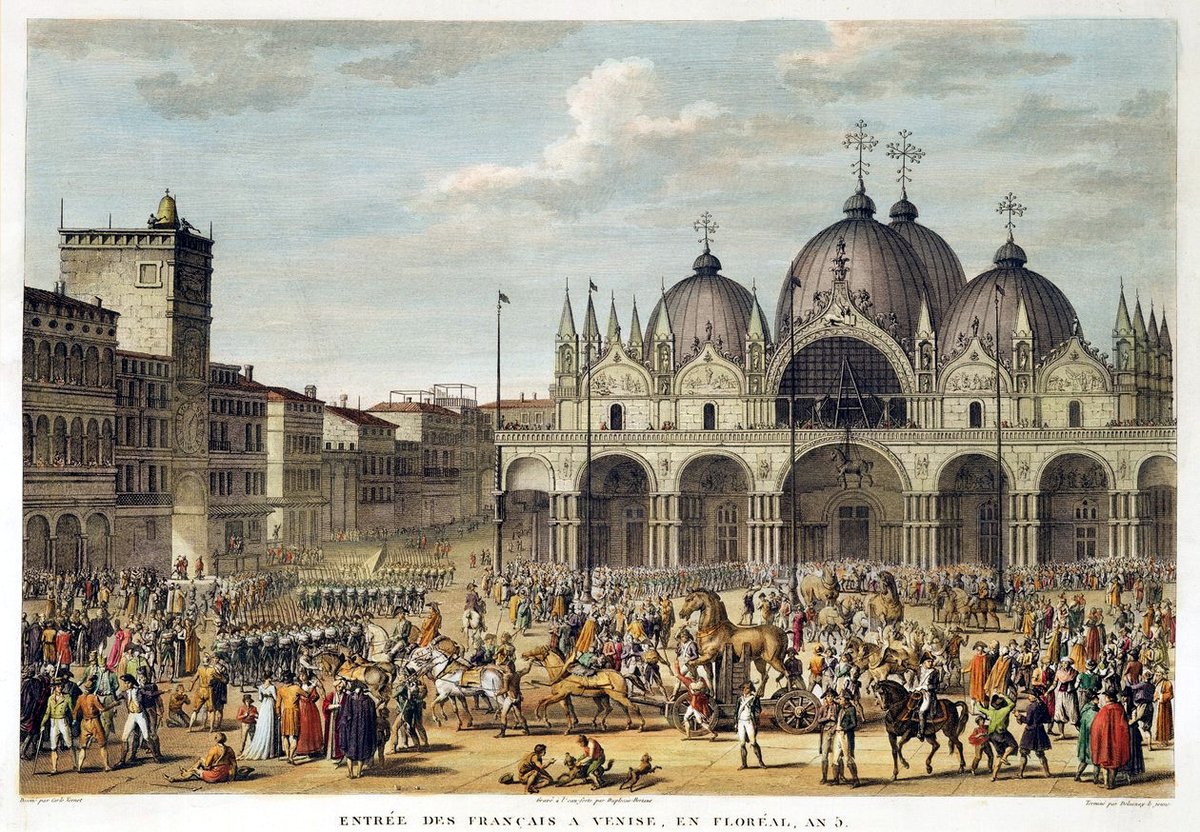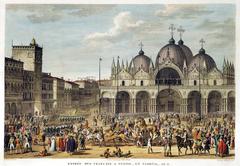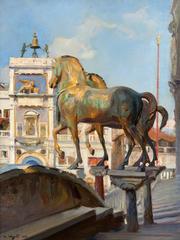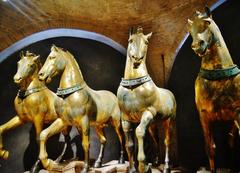
The Horses of Saint Mark in Venice: Visiting Hours, Tickets, and Historical Significance
Date: 14/06/2025
Introduction
The Horses of Saint Mark—also known as the Triumphal Quadriga—are among Venice’s most revered and historically significant monuments. These ancient bronze statues, whose origins can be traced back to the Roman era (2nd or 3rd century CE) and possibly to the Greek sculptor Lysippos, have traveled a remarkable path from the Hippodrome of Constantinople to their current home in St. Mark’s Basilica. Representing the artistic ingenuity and cultural richness of Venice, the horses stand as a testament to the city’s enduring ties between East and West and its prominence in art, politics, and religion.
This guide provides a detailed exploration of the Horses of Saint Mark’s history, their artistic and symbolic significance, and all the practical information you need for a rewarding visit—including opening hours, ticketing, accessibility, and travel tips. Whether you are a history enthusiast or a curious traveler, you’ll find everything you need to experience this unique Venetian treasure to the fullest (St. Mark’s Basilica Official Site, Venice Tourism Official Site, Get Ready For Adventure, The Tour Guy).
Historical Overview
Origins and Creation
The Horses of Saint Mark are four monumental bronze sculptures depicting horses in lifelike, dynamic poses. While traditionally attributed to the Greek sculptor Lysippos (4th century BCE), recent studies suggest a Roman origin from the late 2nd or early 3rd century CE (The Geographical Cure). Originally forming part of a quadriga (four-horse chariot group), the statues were likely created for a triumphal arch or major public building and installed at the Hippodrome of Constantinople.
From Constantinople to Venice: The Fourth Crusade
During the Fourth Crusade in 1204, Venetian forces captured Constantinople and seized the horses as spoils of war. By 1254, they were installed above the main entrance of St. Mark’s Basilica, symbolizing Venice’s military might and its unique role at the crossroads of East and West (St. Mark’s Basilica Official Site).
Napoleonic Seizure and Return
In 1797, Napoleon’s forces removed the horses and transported them to Paris, where they adorned the Arc de Triomphe du Carrousel. After Napoleon’s defeat in 1815, the statues were returned to Venice and reinstated on the basilica’s façade (Get Ready For Adventure).
Conservation and Modern Display
Due to environmental damage and concerns over preservation, the original horses were moved indoors in the 1980s. Today, they are displayed in the Museo di San Marco (Marcian Museum) inside the basilica, while faithful replicas continue to grace the terrace outside (St. Mark’s Basilica Museum).
Artistic and Cultural Significance
Artistic Value and Style
Celebrated for their remarkable realism and craftsmanship, the horses were created using the lost-wax bronze casting technique. Each stands approximately 2.7 meters tall, with powerful musculature, expressive eyes, and flared nostrils—hallmarks of classical naturalism and imperial grandeur. Traces of original gilding suggest they once gleamed with gold (The Geographical Cure).
Symbolism
Throughout history, quadrigas have symbolized triumph, victory, and divine favor. Their placement above St. Mark’s Basilica’s main portal appropriated these imperial meanings for the Venetian Republic, underscoring the city’s independence, religious prestige, and political power (Venice Tourism Official Site).
Influence on Art and Architecture
The Horses of Saint Mark have inspired artists and architects throughout Europe. The quadriga motif appears atop monuments such as Berlin’s Brandenburg Gate and Paris’s Arc de Triomphe du Carrousel, directly referencing the Venetian originals (The Geographical Cure). In Venice, the horses remain a powerful civic symbol.
Visiting the Horses of Saint Mark: Practical Information
Location
- Museum: Museo di San Marco (inside St. Mark’s Basilica)
- Address: Piazza San Marco, 328, 30100 Venezia VE, Italy
Visiting Hours
- Museo di San Marco: Open Tuesday to Sunday, 9:30 AM – 5:00 PM (last entry 4:45 PM). Closed on Mondays and certain holidays. Hours may vary—check the official basilica website before your visit.
Tickets
- Museum Entry: €7 as of 2025 (separate from the basilica entrance). Purchase tickets online to avoid queues.
- Basilica Interior: €3 (Pala d’Oro: additional €5)
- Combo Tickets: Available for the basilica, museum, and terrace. Guided tours often include museum access.
Accessibility
- The museum is on the upper floor and only accessible by stairs; there is no elevator, which may limit access for visitors with mobility issues.
- The main basilica is partially accessible via ramps.
Photography Policy
- Museum: Photography permitted without flash.
- Basilica Interior: Photography not allowed.
- Terrace: Photos of the horse replicas and views of Piazza San Marco permitted; no tripods or flash.
Tips for Visiting
- Book in Advance: Timed-entry tickets are recommended, especially during peak season.
- Dress Code: Shoulders and knees must be covered; bring a scarf or shawl if needed.
- Bag Policy: Large bags and backpacks must be checked at a designated cloakroom.
- Best Times: Visit early morning or late afternoon to avoid crowds. Off-season (November–March) offers a quieter experience.
- COVID-19 Guidelines: Check current health protocols on official sites.
Suggested Itinerary: Integrating Your Visit
- Arrive Early: Enjoy Piazza San Marco before crowds arrive.
- Explore the Basilica: Marvel at mosaics and the Pala d’Oro.
- Ascend to Museo di San Marco: View the original horses and related exhibits.
- Step onto the Terrace: See the replicas and take in panoramic views.
- Visit Nearby: Doge’s Palace, Campanile di San Marco, and Museo Correr are all within walking distance.
- Relax: Enjoy a coffee at Caffè Florian or sample Venetian cicchetti nearby.
Enhancing the Experience: Visuals and Media
- [Insert high-quality images: Horses of Saint Mark in Museo di San Marco, replicas on the terrace, views over Piazza San Marco. Alt text: “Bronze Horses of Saint Mark,” “Horses of Saint Mark at St. Mark’s Basilica,” “Panoramic views from the terrace.“]
- For a virtual experience, see the interactive 360° tour of Piazza San Marco and the Horses of Saint Mark.
Frequently Asked Questions (FAQ)
Q: How do I buy tickets for the Horses of Saint Mark?
A: Purchase tickets online in advance via the official basilica website or authorized vendors.
Q: What are the visiting hours?
A: Museo di San Marco is open 9:30 AM – 5:00 PM, Tuesday to Sunday; check for holiday variations.
Q: Are the original horses outside?
A: The originals are inside the museum; replicas are on the terrace.
Q: Is the museum accessible for people with disabilities?
A: The museum is not wheelchair accessible due to stairs; the main basilica has partial ramp access.
Q: Is photography allowed?
A: Yes, in the museum without flash; not permitted inside the basilica.
Q: What is the best time to visit?
A: Early mornings or late afternoons are less crowded; avoid peak cruise ship hours.
Further Reading and Official Resources
Summary
The Horses of Saint Mark are a unique synthesis of ancient artistry and Venetian identity, their legacy shaped by centuries of political upheaval, restoration, and reverence. By planning your visit with awareness of opening hours, ticketing, and accessibility, you can fully explore this extraordinary monument and its surrounding treasures in Piazza San Marco. For up-to-date information and expert tips, consult official resources and consider using the Audiala app for digital guides and real-time updates.
Explore related articles:















































































































